Dark Star Myths and Symbols
Graffiti in Garway Church
This unusual piece of vandalism is in Garway Church, the original image of which
appears in "The Holy Blood and the Holy Grail" book, which of course was the
precursor of the Da Vinci Code.
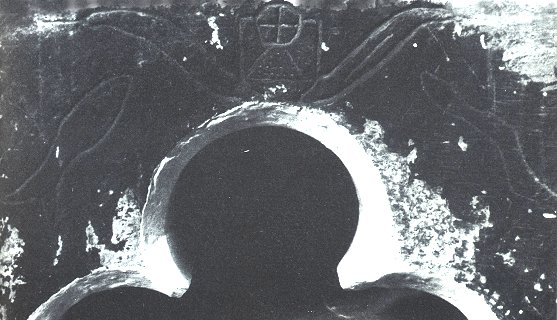
It appears in the last section of plates
with the following description:
"32. Graffiti on the head
of the piscina in the south chapel of Garway church, showing a winged pyramid
and solar emblem, a fish and a snake."
This imagery caught my eye because it not only contains very unusual Winged Disc
symbolism (actually and Nibiruan cross atop a pyramid), but puts it in a
celestial context in the form of a fish and a snake. Are these
constellations? Do their relative positions tell us something about the
orbit of Nibiru?
I am indebted to Damon Elkins for getting
hold of this image for me. He has a similar interest in the orbit of
Nibiru, and passed on these thoughts about the Garway Graffiti:
1. The shape of the "piscina" is that "club" within the
"sign of the rose" in "The DaVinci Code".
2. The "horns" above the "head of the piscina" are much like the "belly of
Hydra" across which my path of Nibiru crosses.
3. The "horns" appear more like a serpent than like horns.
4. The "lines" left of the fish resemble Pisces (the constellation), and my
proposed path of Nibiru passes just "under Pisces and across the pentagonal
figure at the long end away from the check mark.
5. The "winged pyramid" appears to me to be multiple pyramids.
6. The circle with crossed lines is much like the symbols for "the planet of the
crossing".
There is self-evident Christian symbolism
being deployed here. But how unusual to apply the cross into the context
of the Winged Disc! Especially whilst including a pyramid.
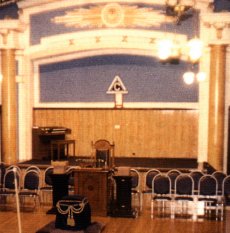
This
makes me wonder whether the symbolism is Masonic, or something of that ilk.
Winged Discs appear in some Masonic Temples after all, in the guise of their
Blazing Star:
The Throne of Zeus
This imposing throne of Zeus, the supreme Greek god on Olympus,
shows a radiance of red fire. There is celestial, astronomical imagery
here, clearly shown by the appearance of a bright star above the throne.
Zeus is said to court the many women he pursued by taking various forms,
including the bull.

Detail from 'Jupiter and Semele', by Gustave Moreau, 1896
This implies that the celestial object he represents made a passage through
various constellations associated with him, including Taurus.
"Semele, encouraged by Hera, persuaded
Zeus to show himself in all his splendour. When he appeared before her as
the radiant god of thunder and lightning, Semele was consumed by the flames and,
dying, gave birth prematurely to Dionysus, whom Zeus saved from the fire.
In this powerful Symbolist version of the myth, the great god radiates fiery,
blood-red lightning. A winged child hiding from the light could be
Dionysus, while the dark, horned god seems to be a fusion of Hades and Pan".
Reference:
(A. Cotterell
and R. Storm "  The Ultimate Encyclopedia of Mythology " Anness 2003)
The Ultimate Encyclopedia of Mythology " Anness 2003)
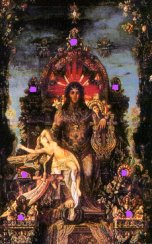
The
fiery, red lightning is very similar to the description of Marduk during the
Celestial Battle of the Mesopotamian creation myth, the Enuma Elish. I
think both are examples of Dark Star symbolism and describe the appearance of
the binary brown dwarf amongst the known planets. That, in this case, Zeus
appears in different parts of the sky and courts various women (stars?) is very
much in keeping with the erratic perihelion passages of this object.
The throne captures much of the symbolism of the Dark Star;
its red aura, the darkness around it, and also seven significant points marks by
various objects attached to the throne (shown right). These indicate to me
the arrangement of objects travelling with the Dark Star. They are the moons of
the Dark Star, both greater and lesser, encompassing the planetary system of the
brown dwarf.
The myth of Semele being destroyed and giving birth to
Dionysus is similar to the Celestial Between Marduk and Tiamat, where the latter
is broken apart by the power of the usurper god, forming the Earth.
The Phoenix
in the Alchemical Trinity
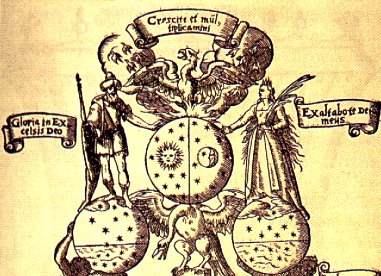
A. Libavius, 'Alchymia', Frankfurt 1606
"The third Work [of the Opus Magnum], beginning
with the royal wedding, brings the birth of the phoenix: the solar tincture of
the red elixir".
Reference:
A. Roob "
 Alchemy & Mysticism " Taschen
2001, p301
Alchemy & Mysticism " Taschen
2001, p301
2 Suns on Ancient Bronze Mirror
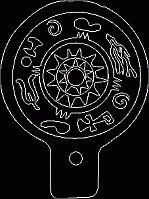
The ancient calendar on the bronze mirror. The first sun is included in the second sun.
They represent the stages of the creation of
the Universe.
While
researching information on Zoroaster,
Glenda Michelle Gable
ran across the web site "THE SLAVONIC ANTIQUITY" by
Sergei V. Rjabchikov on the public.kubsu.ru website (NB The relevant webpages
are no longer available online).
Glenda writes:
The Number 5 caught my attention
I guess because of the ancient HOPI, MAYA, (and I think)
EGYPTIAN legend of presently being in the 5th sun with the arrival of the
6th sun close at hand:
"One
Proto-Byblian text (Gelb 1963, fig. 84) reads: (The signs meaning
'number 1' and 'the sun') ve Pi Vo-u-to THE SUN. Zapa (THE
SUNSETTING)-u. (Number) 5. '(The god) Vit (the god Vuto of
the Phaistos disk) is in the ground (lit. 'in Pi', cf. the name
of
Api,
the Scythian goddess of the earth). The waiting (3) for the sun after a
night. The sacral
number 5'."
"The sign of the
mirror corresponding to October - December is the head of a horse. A
Scythian silver amphora (Galanina, Domansky and Smirnova 1981: 43,
photo) is decorated with the sign of a
winged horse. 11 petals (months) is depicted above its head.
Hence a horse symbolizes a certain month of the Scythian (Sarmatian)
calendar. Interestingly, in conformity with the data of the excavations
of the Indo-Aryan burials (Shilov 1995: 205), the skulls of horses
indicate the sunsetting in winter. It is known that the Indo-Aryan god Agni 'Fire' became like a horse and a man (Shilov 1995: 203).
Russian loshad' 'horse' is comparable with Old Church Slavonic
l'shchati 'to shine' (Rjabchikov 1998a: 8).
"The horse Dadhikra of the Indo-Aryan mythology played a role of the sun
swimming through the ocean of the other world (Shilov 1995: 202).
This horse was closely connected with the deity Agni (Toporov
1991a). The wise man Dadhyanc who was closely connected with this
horse received the enclosures for cows (Toporov 1991b).
An Indo-Aryan symbol, number 5, is associated with the horses in several
burials (Shilov 1995: 202). On the other hand, the
Scythian tip of the sheath of a sword (Galanina, Domansky and Smirnova
1981: 104, photo) is covered with 5 signs of the sun (fire).
Conceivably mech-samorub 'the sword which hews itself' mentioned
in Russian fairy-tales conforms to the Scythian sacral sword."
Written by
Andy
Lloyd, 2006
author of 'The Dark Star'
(2005), 'Ezekiel One'
(2009), 'The Followers of
Horus' (2010) and 'Darker Stars' (2019)












